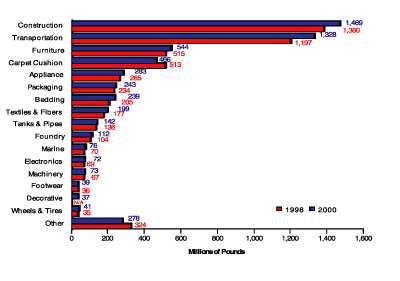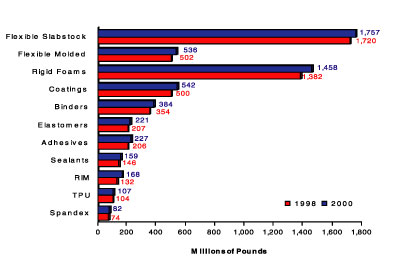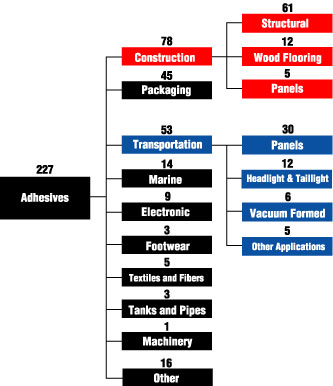Market News
Adhesives and Sealants Account for 7.0% of U.S. Polyurethane Demand

The survey indicated that the North American polyurethanes industry volume for 2000 was 6,373 million pounds. In the United States, volume was 5,548 million pounds, up from 5,327 million pounds in 1998. Canadian volume was 546 million pounds, up from 497 million pounds in 1998. (Fig. 1)

Mexican volume was 279 million pounds; this is the first time that Mexico data has been included in the survey.
The biennial survey addresses the current state of the entire industry and is the result of more than 900 interviews conducted throughout North America. End users, formulators and producers all participated in the survey. Its three main purposes are to quantify the use of polyurethanes by end use, material type and raw materials; to evaluate growth since 1998; and to identify trends affecting material and product usage.
"The survey revealed that the industry experienced a 4.6 percent increase in volume in Canada and the United States," said Joanne Ulnick, a partner at Ducker Research, the marketing firm that conducted the survey. The 6,094 million pounds for the United States and Canada is approximately double the number of pounds consumed in 1989, when usage was first tracked.
The report showed a great deal of consistency with its 1998 counterpart. "When the 1998 survey results were released," said Fran W. Lichtenberg, API Executive Director, "it predicted that total industry volume in the United States and Canada for 2000 would be 6,174 million pounds. That prediction was based on the growth rate in 1998. This year's survey shows that while the growth rate appears to have slowed, it has not slowed as drastically as many people feared."
The report also showed that the top six polyurethane end-use applications in the United States remained unchanged from two years ago - construction, transportation, furniture, carpet cushion, appliances and packaging. (Fig. 2)

The two largest U.S. applications, construction and transportation, experienced growth rates of 6.5% (1,380 to 1,469 million pounds) and 10.9% (1,197 to 1,328 million pounds), respectively, from 1998 to 2000.
Flexible polyurethane foams accounted for 40% of total polyurethane demand; rigid polyurethane foams represented 26.5%; coatings represented 9.6%; and binders represented 6.9%. These numbers are nearly identical to the numbers reported in 1998. (Fig. 3)

The survey also reported U.S. demand for polyurethane raw materials as shown in Figure 5. The data demonstrates growth in polymeric MDI (5.5%) and polyether polyols (9.1%), and a total demand for polyurethane raw materials in the year 2000 of 5,641 million pounds.
The End-Use Survey was sponsored by the Alliance for the Polyurethanes Industry, a business unit of the American Plastics Council, and conducted by Ducker Research. For further information, please contact Fran Lichtenberg, Alliance for the Polyurethanes Industry, at 703-253-0652. Or Circle No. 64.
Looking for a reprint of this article?
From high-res PDFs to custom plaques, order your copy today!




